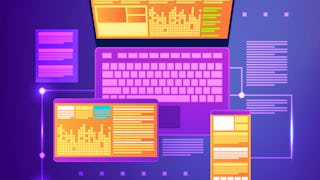Automation in the Cloud can simplify processes, enable agility and scalability, and help you deploy faster. But how should you master these topics to enhance your career potential? The course kicks off by introducing automation in the cloud, comparing the differences between on-premises and cloud. We'll answer why automation is so powerful and you'll get hands-on by working with AWS CLI. Week 1 closes with automation with scripting by sharing examples of how automation helps and the benefits of using scripts. A focus on Automation isn't complete with an overview of Infrastructure as Code. You'll get introduced to Provisioning and Configuration Management and solve an automation problem with AWS CloudFormation. The instructors will then share some simple automation examples and how various tools can help you get the job done. In the course's final week, we'll cover the various AWS Services and features used for automation, how to scale resource management, and use the Systems Manager console and AWS Config for compliance.

Automation in the AWS Cloud
This course is part of multiple programs.


Instructors: Rafael Lopes
8,730 already enrolled
Included with
(79 reviews)
Skills you'll gain
- Software Testing
- Patch Management
- Amazon Elastic Compute Cloud
- Automation
- IT Automation
- Cloud Management
- Infrastructure as Code (IaC)
- Continuous Integration
- Amazon Web Services
- AWS CloudFormation
- Scripting
- Continuous Monitoring
- Command-Line Interface
- Configuration Management
- Infrastructure As A Service (IaaS)
- Bash (Scripting Language)
Details to know

Add to your LinkedIn profile
3 assignments
See how employees at top companies are mastering in-demand skills

Build your subject-matter expertise
- Learn new concepts from industry experts
- Gain a foundational understanding of a subject or tool
- Develop job-relevant skills with hands-on projects
- Earn a shareable career certificate from Amazon Web Services

There are 3 modules in this course
This module starts by defining what the concept of automation means, before moving on to cover some of the basic components that you can use for automation in the cloud. Module 1 is divided in two parts: Introduction to Automation and Automation with Scripting. During the first part of the module (Introduction to Automation), the you learn about the context of automation in the course and explore how cloud computing facilitates automated tasks. You also learn more about APIs and the basics of how to use the AWS Command Line Interface (AWS CLI). In the second part of this module (Automation with Scripting), you get an introduction to the basics of scripting languages, learn about best practices for writing scripts, and receive a crash course in the Bash scripting language. This module also offers a hands-on lab focused on using the AWS CLI for Automation so you can gain practical experience with scripting tasks.
What's included
8 videos4 readings1 assignment1 app item1 discussion prompt2 plugins
In the second module of the course, you focus your learning on a relevant industry topic: automating things by using code, which is also known as infrastructure as code (IaC). Understanding IaC is crucial for operationalizing automation. With proper IaC, you can start automating how you provision infrastructure in a declarative way, instead of writing scripts for every task. This module is designed so that you gain a solid understanding about AWS CloudFormation and its importance for automation. This module is also subdivided into two major topics: Infrastructure as Code and Configuration as Code. First, you learn about the difference between IaC and configuration as code before exploring the details of each modality. IaC focuses on provisioning architectures by using a declarative language. In contrast, configuration as code focuses on using automation to configure fleets of servers that are currently running. This module also provides readings and hands-on activities that focus on AWS CloudFormation, so that you can learn about CloudFormation by using it.
What's included
9 videos2 readings1 assignment1 app item
Similar to the previous modules, the final module in this course is divided in two segments: Resource Management Best Practices and Scaling Resource Management. In Resource Management Best Practices, you start by learning some techniques for provisioning Amazon Elastic Compute Cloud (Amazon EC2) instances. You learn about and compare different methods of instance bootstrapping, and learn about EC2 instance metadata—a dedicated layer where instances can get information about themselves. You also explore ideas about how to combine these features to create automation solutions, and best practices on how to for organizing AWS resources by using tags for compliance and access control. In Scaling Resource Management, you learn how to use AWS Systems Manager and AWS Config to set up automation for maintenance and continuous compliance. This module includes readings and a hands-on activity with Systems Manager.
What's included
8 videos2 readings1 assignment1 app item1 plugin
Earn a career certificate
Add this credential to your LinkedIn profile, resume, or CV. Share it on social media and in your performance review.
Instructors

Offered by
Explore more from Cloud Computing
 Status: Free Trial
Status: Free Trial Status: Preview
Status: Preview Status: Free Trial
Status: Free Trial
Amazon Web Services
Why people choose Coursera for their career





Open new doors with Coursera Plus
Unlimited access to 10,000+ world-class courses, hands-on projects, and job-ready certificate programs - all included in your subscription
Advance your career with an online degree
Earn a degree from world-class universities - 100% online
Join over 3,400 global companies that choose Coursera for Business
Upskill your employees to excel in the digital economy
Frequently asked questions
To access the course materials, assignments and to earn a Certificate, you will need to purchase the Certificate experience when you enroll in a course. You can try a Free Trial instead, or apply for Financial Aid. The course may offer 'Full Course, No Certificate' instead. This option lets you see all course materials, submit required assessments, and get a final grade. This also means that you will not be able to purchase a Certificate experience.
When you enroll in the course, you get access to all of the courses in the Certificate, and you earn a certificate when you complete the work. Your electronic Certificate will be added to your Accomplishments page - from there, you can print your Certificate or add it to your LinkedIn profile.
More questions
Financial aid available,